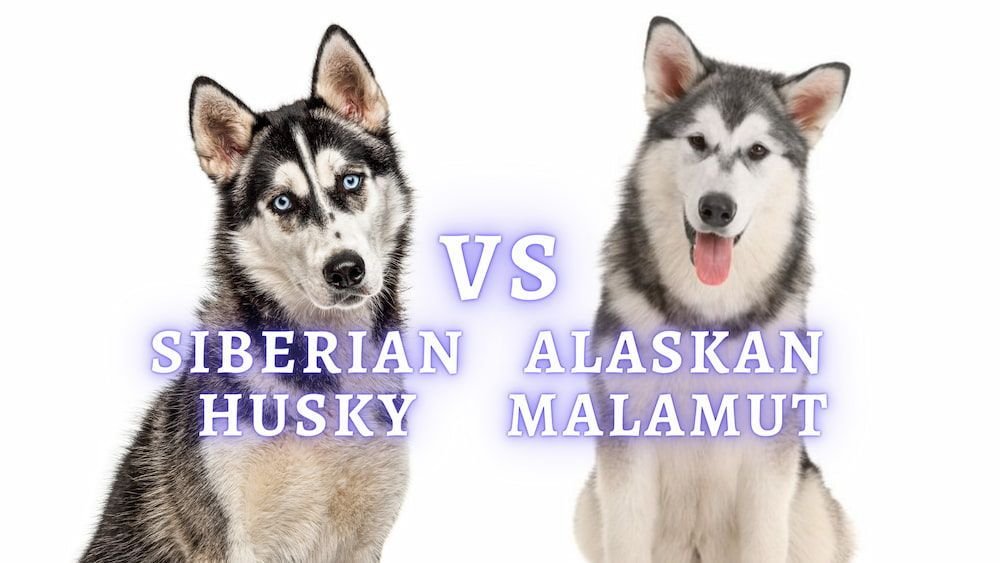Siberian Huskies vs Alaskan Malamutes
Although the Siberian husky and Alaskan malamute are both Arctic working dogs, the Siberian husky was bred for speed in Northern Asia whereas the Alaskan malamute is thought to have been descended from the original wolf dogs who accompanied the first travelers over the Bering Strait to North America.
Huskies, utilized for hauling light loads at a swift pace, gained popularity around the world when they began winning sled races at the start of the twentieth century. By comparison, malamutes were used to haul larger, heavier loads, working together as teams to move these laden sleds over long distances at a slow and steady pace.
The husky usually stands between 20 and 24 inches in height. Females are typically smaller and weigh between 35 and 50 pounds, with males weighing between 45 and 60 pounds. While the malamute isn’t much taller, ranging between 23 and 25 inches in height, the breed is far bulkier, with females weighing about 75 pounds and males weighing about 85 pounds.
Both huskies and malamutes, bred in cold climates, boast thick, double coats designed to keep them warm, but the malamute tends to have longer hair than the husky. And although both breeds have white underbellies, the husky’s brush tail points downward while the malamute’s bushier tail, carried over his back, waves in the air like a feathered plume. Both breeds shed their entire undercoat (this is called “blowing the coat”) twice a year – a process that takes shedding to the extreme and requires far more frequent brushings to help keep their hair under control.
Where coloring is concerned, both breeds’ coats can run the gamut from black and gray to white and varying shades of red. As for their faces, many huskies have markings that resemble white masks with coloring around or over their eyes and down their noses, while malamutes have fuller, unmarked faces topped by heart-shaped “caps” on their heads. The most striking difference between them, however, is the husky’s brilliant blue eyes. Alternatively, some huskies will have one blue eye and one brown eye and others will have two brown eyes.
Temperamentally, both breeds are extremely friendly, even towards strangers, rendering them unreliable as guard dogs, so eager are they to greet every person they meet! And as pack animals, they’re both very loving and very loyal. Huskies, though, are happiest spending most of their time with their families, human and/or canine, and aren’t overly fond of being alone. Malamutes are more independent, savoring some time on their own, and since they can, on occasion, be reactive towards other dogs, often fare better being the only pet in the family.
As working dogs, mental and physical stimulation is a MUST for them both. Huskies, with their preference for running, can usually get all the exercise they require by running around a large, securely fenced backyard. Malamutes prefer going for swims or on hikes, especially if it affords them the opportunity to carry a “pack.” With no outlet for their pent-up energy, both breeds will not only grow bored, they’ll develop bad habits such as chewing and digging.
The lifespan of a husky is between 10 and 14 years and a malamute’s is between 10 and 12 years. Of the two breeds, huskies have fewer health issues but they’re at risk for cataracts, requiring regular eye exams to catch them early should they develop, and are prone to hip issues as they age. Malamutes, on the other hand, are predisposed to chondrodysplasia (dwarfism), day blindness, elbow dysplasia, hip dysplasia, hypothyroidism, inherited polyneuropathy (resulting in nerve pain), thrombopathia (a platelet disorder) and von Willebrand’s disease (a bleeding disorder).
Summation: While the Siberian husky and Alaskan malamute were both bred in the cold for the cold, they’re both more than eager to warm the laps and enrich the lives of any active and affectionate family whatever the clime.


